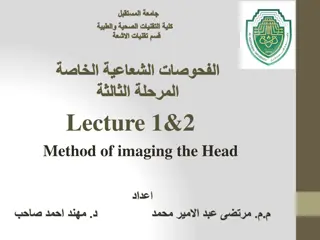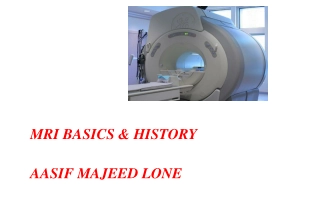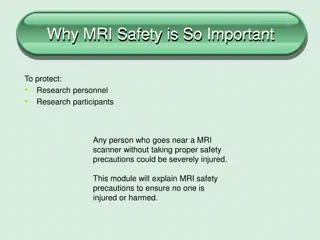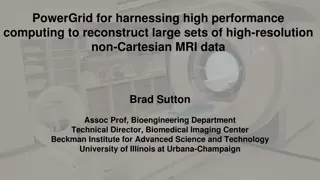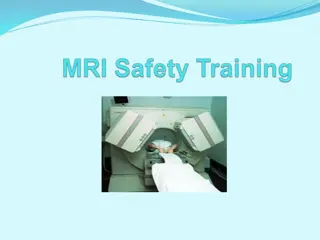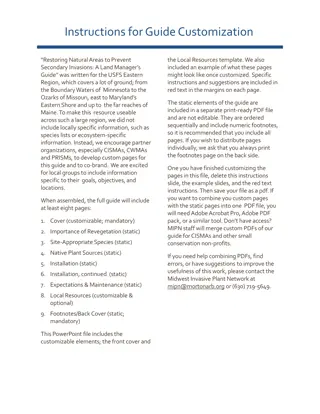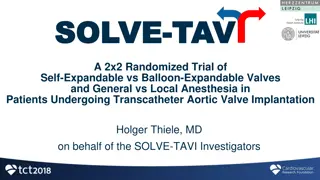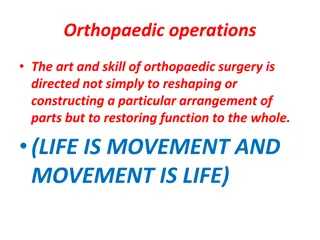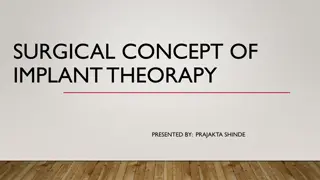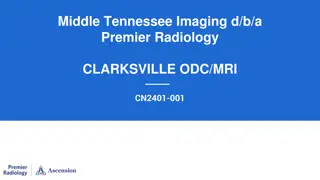MRI Safety Review of Non-Invasive Expandable Orthopaedic Implants
This review discusses the safety considerations surrounding non-invasive expandable orthopaedic implants, focusing on the potential challenges these dynamic implants pose during MR imaging. It highlights the distinction between passive and dynamic implants, emphasizing the need for accurate identification to ensure patient safety and optimize imaging outcomes.
Download Presentation

Please find below an Image/Link to download the presentation.
The content on the website is provided AS IS for your information and personal use only. It may not be sold, licensed, or shared on other websites without obtaining consent from the author. Download presentation by click this link. If you encounter any issues during the download, it is possible that the publisher has removed the file from their server.
E N D
Presentation Transcript
MR safety review of non- Invasive expandable Orthopaedic Implants James McDermott and John McLean
Background NHS GGC s generic implant safety procedure (GISP) for orthopaedic implants covers fixed, passive, internal orthopaedic implants. For a fuller description, see the MRI physics website www.mriphysics.scot.nhs.uk/implant-safety-policies/fixed-internal-orthopaedic-implants This policy excludes non-invasively expandable orthopaedic (NEO) implants. NEO implants have a dynamic capability and when coupled to an external power source these implants can be expanded without the need for surgical intervention. Some of the implants have magnetic components and some have springs which are all ferrous. This raises the practical problem of confirming whether a patient s orthopaedic implant is a passive orthopaedic implant such that one would be confident to apply the fixed, internal, passive policy orthopaedic implant policy and allow an MR scan to proceed
Background Here we present information on 4 NEO implants The intension is to provide information that will help the MR radiographer or technologist to exclude the presence of one of the NEO implants The aim is to ensure no patient is unnecessarily rejected or delayed from having their MR scan due concerns that a patient s orthopaedic implant is an NEO implant It is up to local sites and individual to assess the risk and benefits to any individual patient and determine their own approach to reviewing this information and their own local sources of information
Background Traditional expandable orthopaedic implants are lengthened via surgery. However, there are a small number of orthopaedic implants that allow non-invasive expansion by an external power source These implants are typically used in paediatric cases and cases of younger adults, where the benefit of the implant is that it can grow or expand as the patient grows without the need for further surgical intervention.
REPIPHYSIS Expandable Prosthesis First custom made, non-invasive expandable orthopaedic implant developed and distributed worldwide limb salvage system for bone sarcoma patients. Multiple companies have had rights over the design and production (Phenix Technologies France, Wright Medical Technologies USA, MicroPort Orthopaedics Inc & Onkos Surgical). We believe the production of this prosthesis has been discontinued though we do not have confirmation of this
REPIPHYSIS Expandable Prosthesis An external magnetic field induces heat within the locking mechanism; prosthesis expands via the expelling force of a compressed spring. We do not have formal MR safety labelling information so we deem this device MR Unlabelled Testing of the prosthesis under MRI at 1.5 T caused no measurable change in prosthesis length or significant temperature rises. Appears to be safe to scan under 1.5 T
Stanmore JTS Extendible Implant Custom-built prosthesis for limb lengthening in bone sarcoma patients. Currently developed and built in UK by Stanmore Implants Worldwide Ltd (owned by Stryker Corporation) first patient in 2002. Consists of 2 titanium shafts connected by a gearbox external rotating magnet rotates internal permanent magnet to extend prosthesis. JTS Implant labelled as MR Unsafe.
NuVasive PRECICE Extendable Rod First produced in 2011 by NuVasive USA Magnetic intramedullary nail made from titanium, aimed at treating patients with limb length discrepancies. The PRECICE gained CE mark approval for distribution throughout Europe in 2019, followed by a brief suspension and reinstatement of the CE mark in 2021.
NuVasive PRECICE Extendable Rod Nail contains a rare earth permanent magnet and a mechanical gear shaft that rotates when actuated by a motor driven external remote control (ERC) lengthens the rod. Patient lengthens the rod daily using the ERC over a period of a few months implant usually removed within a year of surgery. MR Unsafe Testing shows no considerable distention, increase in temperature or reduction in distraction force post MRI under 1.5 T
NuVasive MAGEC Spinal Deformity System Spinal Distraction Rods designed for early onset scoliosis patients. First CE Mark approved in 2009 whilst under Ellipse Technologies Taken over by NuVasive in 2016. MHRA requested that NuVasive suspend supply of MAGEC to UK in 2020 led to suspension of CE mark in March 2021. CE mark reinstated in November 2021 but MHRA have yet to review their position in UK.
NuVasive MAGEC Spinal Deformity System Either single or dual titanium rods may be implanted. Rods have an expansion device in their mid-portions containing a ratchet apparatus moved by internal neodymium magnets -lengthened using an external magnetic remote controller (ERC) placed over the spine (Outpatient Procedure). MR Conditional: 1.5 T Max SAR of 0.5 W/kg Max Field Gradient of 30 T/m
Conclusions Information on four non-invasively expandable orthopaedic implant has been collated Schematic images, x-rays and picture of extension kit as well as information on the market availability of these products have been provided to help radiographers and technologists exclude the presence of these implants for their patients Where the presence of these implants has been confirmed. We hope information provided here can help inform risk-benefit assessments If you scan a patient with one the MR Unsafe or Unlabelled devices, please let us know via MOSAES (https://www.mriphysics.scot.nhs.uk/mosaes/)


